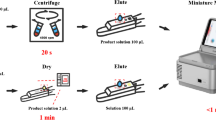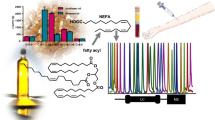Abstract
Phosphatidylethanol species (PEths) are promising biomarkers of alcohol consumption. Here, we report on the set-up, validation, and application of a novel UHPLC-ESI-MS/MS method for the quantification of PEth 16:0/18:1, PEth 18:1/18:1, and PEth 16:0/16:0 in whole blood (30 μL) and in venous (V, 30 μL) or capillary (C, 3 punches (3 mm)) dried blood spots (DBS). The methods were linear from 10 (LLOQ) to 2000 ng/mL for PEth 16:0/18:1, from 10 (LLOQ) to 1940 ng/mL for PEth 18:1/18:1, and from 19 (LLOQ) to 3872 ng/mL for PEth 16:0/16:0. Extraction efficiencies were higher than 55 % (RSD < 18 %) and matrix effects compensated for by IS were between 77 and 125 % (RSD < 10 %). Accuracy, repeatability, and intermediate precision fulfilled acceptance criteria (bias and RSD below 13 %). Validity of the procedure for determination of PEth 16:0/18:1 in blood was demonstrated by the successful participation in a proficiency test. The quantification of PEths in C-DBS was not significantly influenced by the hematocrit, punch localization, or spot volume. The stability of PEths in V-DBS stored at room temperature was demonstrated up to 6 months. The method was applied to authentic samples (whole blood, V-DBS, and C-DBS) from 50 inpatients in alcohol withdrawal and 50 control volunteers. Applying a cut-off value to detect inpatients at 221 ng/mL for PEth 16:0/18:1 provided no false positive results and a good sensitivity (86 %). Comparison of quantitative results (Bland-Altman plot, Passing-Bablok regression, and Wilcoxon signed rank test) revealed that V-DBS and C-DBS were valid alternatives to venous blood for the detection of alcohol consumption.

Passing-Bablok regression analysis of PEth 16:0/18:1 concentrations measured in blood and in capillary DBS, demonstrating equivalence of PEth concentrations in both matrices





Similar content being viewed by others
References
Joya X, Friguls B, Ortigosa S, Papaseit E, Martínez SE, Manich A, Garcia-Algar O, Pacifici R, Vall O, Pichini S (2012) Determination of maternal-fetal biomarkers of prenatal exposure to ethanol: a review. J Pharm Biomed Anal 69:209–222
Cabarcos P, Álvarez I, Tabernero M, Bermejo A (2015) Determination of direct alcohol markers: a review. Anal Bioanal Chem 407(17):4907–4925
Varga A, Hansson P, Johnson G, Alling C (2000) Normalization rate and cellular localization of phosphatidylethanol in whole blood from chronic alcoholics. Clin Chim Acta 299(1–2):141–150
Aradóttir S, Seidl S, Wurst FM, Jönsson BAG, Alling C (2004) Phosphatidylethanol in human organs and blood: a study on autopsy material and influences by storage conditions. Alcohol Clin Exp Res 28(11):1718–1723
Gnann H, Engelmann C, Skopp G, Winkler M, Auwärter V, Dresen S, Ferreirós N, Wurst F, Weinmann W (2010) Identification of 48 homologues of phosphatidylethanol in blood by LC-ESI-MS/MS. Anal Bioanal Chem 396(7):2415–2423
Nalesso A, Viel G, Cecchetto G, Mioni D, Pessa G, Favretto D, Ferrara SD (2011) Quantitative profiling of phosphatidylethanol molecular species in human blood by liquid chromatography high resolution mass spectrometry. J Chromatogr A 1218(46):8423–8431
Helander A, Zheng Y (2009) Molecular species of the alcohol biomarker phosphatidylethanol in human blood measured by LC-MS. Clin Chem 55(7):1395–1405
Zheng Y, Beck O, Helander A (2011) Method development for routine liquid chromatography-mass spectrometry measurement of the alcohol biomarker phosphatidylethanol (PEth) in blood. Clin Chim Acta 412(15–16):1428–1435
Gnann H, Thierauf A, Hagenbuch F, Röhr B, Weinmann W (2014) Time dependence of elimination of different PEth homologues in alcoholics in comparison with social drinkers. Alcohol Clin Exp Res 38(2):322–326
Viel G, Boscolo-Berto R, Cecchetto G, Fais P, Nalesso A, Ferrara S (2012) Phosphatidylethanol in blood as a marker of chronic alcohol use: a systematic review and meta-analysis. Int J Mol Sci 13(11):14788–14812
Aradottir S, Asanovska G, Gjerss S, Hansson P, Alling C (2006) Phosphatidylethanol (PEth) concentrations in blood are correlated to reported alcohol intake in alcohol-dependent patients. Alcohol Alcohol 41(4):431–437
Gunnarsson T, Karlsson A, Hansson P, Johnson G, Alling C, Odham G (1998) Determination of phosphatidylethanol in blood from alcoholic males using high-performance liquid chromatography and evaporative light scattering or electrospray mass spectrometric detection. J Chromatogr B Biomed Sci Appl 705(2):243–249
Varga A, Nilsson S (2008) Nonaqueous capillary electrophoresis for analysis of the ethanol consumption biomarker phosphatidylethanol. Electrophoresis 29(8):1667–1671
Tolonen A, Lehto TM, Hannuksela ML, Savolainen MJ (2005) A method for determination of phosphatidylethanol from high density lipoproteins by reversed-phase HPLC with TOF–MS detection. Anal Biochem 341(1):83–88
Faller A, Richter B, Kluge M, Koenig P, Seitz H, Thierauf A, Gnann H, Winkler M, Mattern R, Skopp G (2011) LC-MS/MS analysis of phosphatidylethanol in dried blood spots versus conventional blood specimens. Anal Bioanal Chem 401(4):1163–1166
Kwak HS, Han J-Y, Ahn H-K, Kim M-H, Ryu H-M, Kim M-Y, Chung H-J, Cho D-H, Shin C-Y, Velazquez-Armenta EY, Nava-Ocampo AA (2012) Blood levels of phosphatidylethanol in pregnant women reporting positive alcohol ingestion, measured by an improved LC-MS/MS analytical method. Clin Toxicol 50(10):886–891
Varga A, Hansson P, Lundqvist C, Alling C (1998) Phosphatidylethanol in blood as a marker of ethanol consumption in healthy volunteers: comparison with other markers. Alcohol Clin Exp Res 22(8):1832–1837
Jones J, Jones M, Plate C, Lewis D (2011) The detection of 1-palmitoyl-2-oleoyl-sn-glycero-3-phosphoethanol in human dried blood spots. Anal Methods 3(5):1101–1106
Schröck A, Thierauf A, Wurst FM, Thon N, Weinmann W (2014) Progress in monitoring alcohol consumption and alcohol abuse by phosphatidylethanol. Bioanalysis 6(17):2285–2294
Gnann H, Weinmann W, Engelmann C, Wurst FM, Skopp G, Winkler M, Thierauf A, Auwärter V, Dresen S, Bouzas NF (2009) Selective detection of phosphatidylethanol homologues in blood as biomarkers for alcohol consumption by LC-ESI-MS/MS. J Mass Spectrom 44(9):1293–1299
Bakhireva LN, Leeman L, Savich RD, Cano S, Gutierrez H, Savage DD, Rayburn WF (2014) The validity of phosphatidylethanol in dried blood spots of newborns for the identification of prenatal alcohol exposure. Alcohol Clin Exp Res 38(4):1078–1085
Stove CP, Ingels AS, De Kesel PM, Lambert WE (2012) Dried blood spots in toxicology: from the cradle to the grave? Crit Rev Toxicol 42(3):230–243
Bakhireva LN, Savich RD, Raisch DW, Cano S, Annett RD, Leeman L, Garg M, Goff C, Savage DD (2013) The feasibility and cost of neonatal screening for prenatal alcohol exposure by measuring phosphatidylethanol in dried blood spots. Alcohol Clin Exp Res 37(6):1008–1015
Faller A, Richter B, Kluge M, Koenig P, Seitz HK, Skopp G (2012) Stability of phosphatidylethanol species in spiked and authentic whole blood and matching dried blood spots. Int J Legal Med 127(3):1–8
Hernandez Redondo A, Schroeck A, Kneubuehl B, Weinmann W (2013) Determination of ethyl glucuronide and ethyl sulfate from dried blood spots. Int J Legal Med 127(4):769–775
Sadones N, Capiau S, De Kesel PM, Lambert WE, Stove CP (2014) Spot them in the spot: analysis of abused substances using dried blood spots. Bioanalysis 6(17):2211–2227
Jager NGL, Rosing H, Schellens JHM, Beijnen JH (2014) Procedures and practices for the validation of bioanalytical methods using dried blood spots: a review. Bioanalysis 6(18):2481–2514
De Kesel PM, Sadones N, Capiau S, Lambert WE, Stove CP (2013) Hemato-critical issues in quantitative analysis of dried blood spots: challenges and solutions. Bioanalysis 5(16):2023–2041
Wille S, Peters F, Di Fazio V, Samyn N (2011) Practical aspects concerning validation and quality control for forensic and clinical bioanalytical quantitative methods. Accredit Qual Assur 16(6):279–292
Committee for medicinal products for human use (CHMP), European medicines agency (EMEA) (2011) Guideline on validation of bioanalytical methods, London. http://www.ema.europa.eu/docs/en_GB/document_library/Scientific_guideline/2011/08/WC500109686.pdf. Accessed 15 June 2015
Matuszewski BK, Constanzer ML, Chavez-Eng CM (2003) Strategies for the assessment of matrix effect in quantitative bioanalytical methods based on HPLC-MS/MS. Anal Chem 75(13):3019–3030
Miller JN, Miller JC (2010) Statistics and Chemometrics for Analytical Chemistry 6rd edn Pearson Education Limited England
Sadones N, Archer JR, Ingels AS, Dargan PI, Wood DM, Wood M, Neels H, Lambert WE, Stove CP (2015) Do capillary dried blood spot concentrations of gamma-hydroxybutyric acid mirror those in venous blood? a comparative study. Drug Test Anal 7(4):336–340
Koster RA, Alffenaar JW, Botma R, Greijdanus B, Uges DR, Kosterink JG, Touw DJ (2015) The relation of the number of hydrogen-bond acceptors with recoveries of immunosuppressants in DBS analysis. Bioanalysis 7(14):1717–1722
Frega NG, Pacetti D, Boselli E (2012) Characterization of phospholipid molecular species by means of HPLC-tandem mass spectrometry, tandem mass spectrometry—applications and principles, InTech. Available from: http://www.intechopen.com/books/tandem-mass-spectrometry-applications-and-principles/characterization-of-phospholipid-molecular-species-by-means-of-hplc-tandem-mass-spectrometry. Accessed 25 October 2015
Denniff P, Spooner N (2010) The effect of hematocrit on assay bias when using DBS samples for the quantitative bioanalysis of drugs. Bioanalysis 2(8):1385–1395
Stewart SH, Koch DG, Willner IR, Anton RF, Reuben A (2014) Validation of blood phosphatidylethanol as an alcohol consumption biomarker in patients with chronic liver disease. Alcohol Clin Exp Res 38(6):1706–1711
Acknowledgments
The authors wish to thank all the staff from the Brugmann Hospital and the Military Hospital in Brussels for their contribution and all volunteers for their collaboration.
Author information
Authors and Affiliations
Corresponding author
Ethics declarations
Financial and competing interests disclosure
The authors have no relevant affiliations or financial involvement with any organization or entity with a financial interest in or financial conflict with the subject matter or materials discussed in the manuscript. This includes employment, consultancies, honoraria, stock ownership or options, expert testimony, grants or patents received or pending, or royalties. No writing assistance was utilized in the production of this manuscript.
Electronic supplementary material
Below is the link to the electronic supplementary material.
ESM 1
(PDF 1.01 mb)
Rights and permissions
About this article
Cite this article
Kummer, N., Ingels, AS., Wille, S.M.R. et al. Quantification of phosphatidylethanol 16:0/18:1, 18:1/18:1, and 16:0/16:0 in venous blood and venous and capillary dried blood spots from patients in alcohol withdrawal and control volunteers. Anal Bioanal Chem 408, 825–838 (2016). https://doi.org/10.1007/s00216-015-9169-1
Received:
Revised:
Accepted:
Published:
Issue Date:
DOI: https://doi.org/10.1007/s00216-015-9169-1




